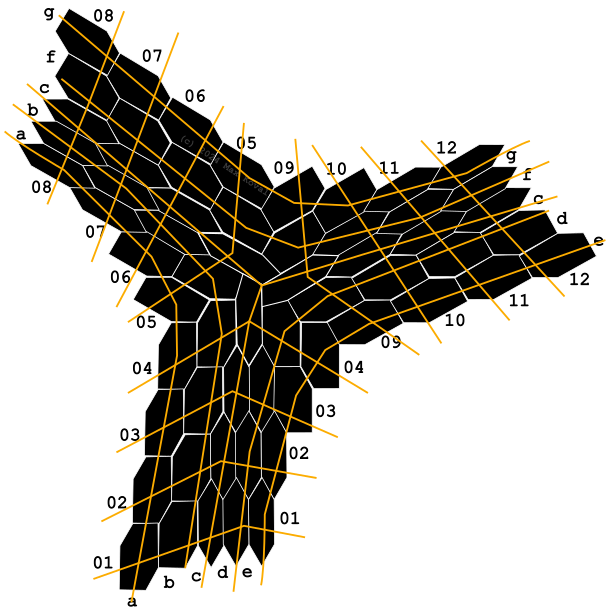Neohex
Neohex is a three-player chess variant designed by Max Koval in 2024. The game is played on an unusual board made of 60 irregular hexagons and uses three red, green and blue-colored sets of standard chess pieces.
The driving idea behind this game was to create a hexagonal chess variant where the bishops will have no dependency on their initial hex color, in order to make their power relatively equal to that of the knights, and reduce their number for a small-range games.
This game uses fewer pieces per side than in standard chess, which usually means a quicker and more fun playing process. The ratio between empty and taken cells remains 50 by 50%, the same as in standard chess.
Setup

Red: king a01; queen b01; bishop c01; knight d01; rook e01; pawn a02, b02, c02, d02, e02.
Green: king g08; queen f08; bishop c08; knight b08; rook a08; pawn g07, f07, c07, b07, a07.
Blue: king e12; queen d12; bishop c12; knight f12; rook g12; pawn e11, d11, c11, f11, g11.
The coordinate system is shown below:

Pieces
Rook
The movement of the rook remains almost the same as in hexagonal chess, and consists of arbitrary number of hexhes in any orthogonal direction (edgewise), along a series of spaces connected by shared sides. When two spaces share a common side, they are considered orthogonally adjacent.
The only difference here is the fact that some hexes share the same side with another hex. (For example, [b05] and [c04] with [c05]). In this case, if approached from […c03, c04], the rook can enter [c05] and continue sliding in its expected way [f05, g05].

When approached from the opposite side of the same orthogonal [g5, f5, c5], its move divides into two separate paths: [b5, a5] and [c4, c3, c2, c1].

Bishop
The bishop moves like a standard hexagonal bishop, aside from the fact that it is no longer colorbound. If it approaches from the [a03, d04]-type hexes, its movement divides into two separate paths [b06, a08] and [c09, d10, e11]. When approached from the opposite way [a08, b06], the direction is changed to [c04, d02].


Queen
The queen moves like the rook and bishop combined.
King
The king moves like the queen, but in one cell in any direction only. Castling is permitted in the long side only.

Knight
The same as in hexagonal chess, but with a twist. It's move can be defined as two sequential steps orthogonally forward and one step orthogonally forward in two possible hexes, excluding the central one (On a normal hexagonal board, it would look like a 60 or 120° turn).


Pawn
The pawn moves passively straight forward (directions shown on the second diagram), or moves to capture diagonally forward. The promotion zone is the 8th and 12th, 01st and 12th and 01st and 08th rows for red, green and blue pieces respectively. If a pawn hasn't moved yet, a two-step option is permitted.

Rules
Everyone plays against everyone. Red moves first, then Blue, then Green, and this move sequence repeats. This move order is always clockwise.
The game ends when the next player in the move order cannot make any legal move. If the player is checked, and cannot make any legal move, then this player loses and gets 0 points (checkmate). The player who can capture the king wins and gets 1 point. The third player gets ½ points. If both opponents can capture the attacked king, the winner is who comes first in the move order.
If the player cannot make any legal move, but their king is not under attack, then the game finishes by a draw (stalemate) and every player get ½ points.
If a player resigns, then in practice, it can be counted that the resigning side gets 0 points, and two other opponents get ¾ points per side.
With all the mentioned exceptions, other rules are the same as in standard chess.
 This 'user submitted' page is a collaboration between the posting user and the Chess Variant Pages. Registered contributors to the Chess Variant Pages have the ability to post their own works, subject to review and editing by the Chess Variant Pages Editorial Staff.
This 'user submitted' page is a collaboration between the posting user and the Chess Variant Pages. Registered contributors to the Chess Variant Pages have the ability to post their own works, subject to review and editing by the Chess Variant Pages Editorial Staff.
By Max Koval.
Last revised by A. M. DeWitt.
Web page created: 2024-03-30. Web page last updated: 2024-04-01
